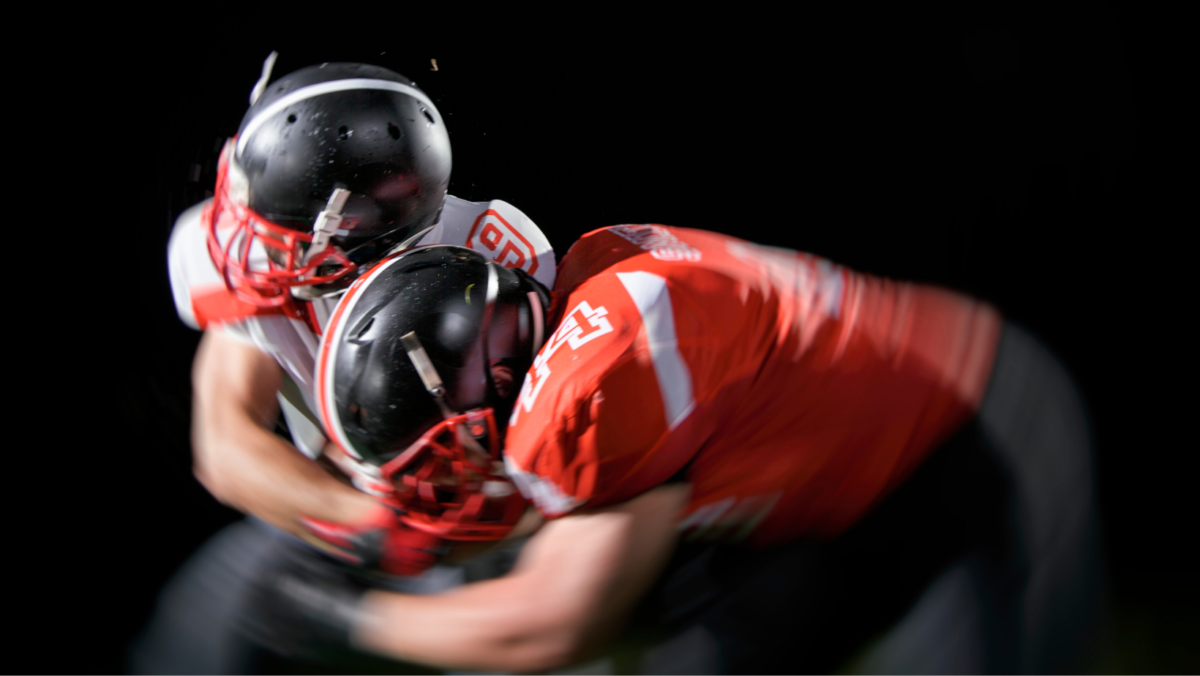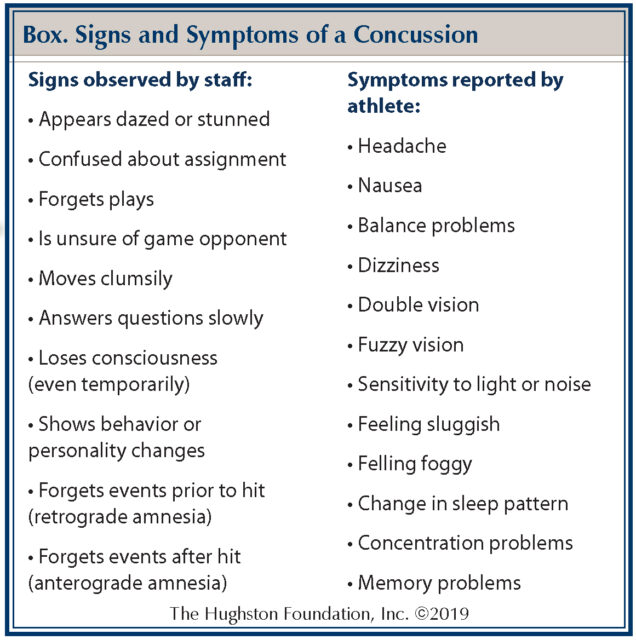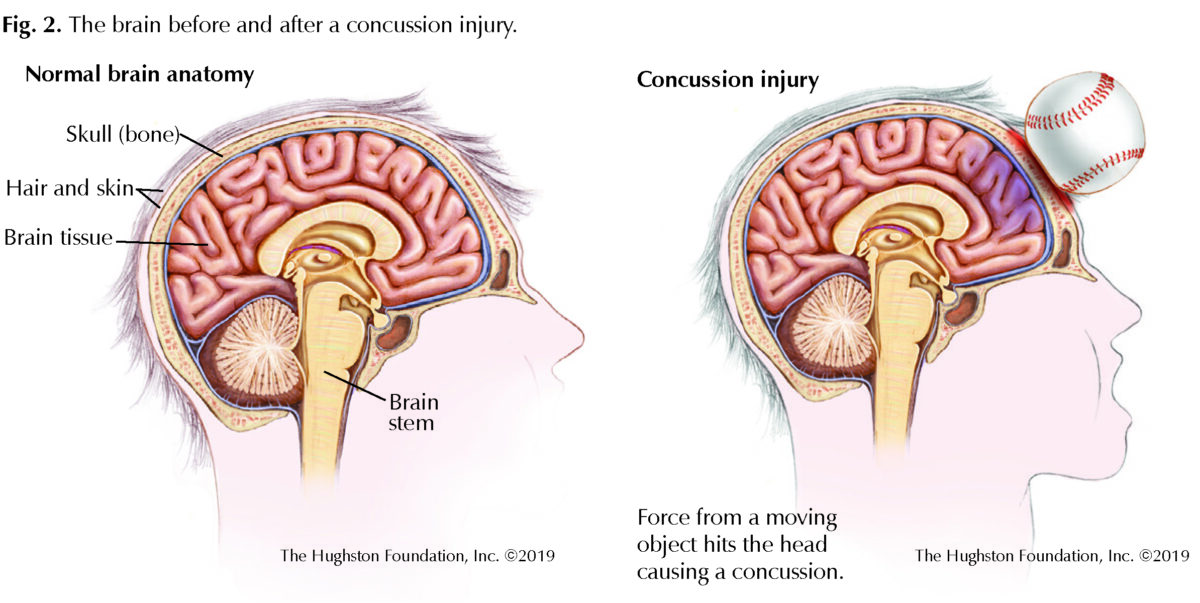
A concussion is a mild traumatic brain injury that results from a blow or sudden movement to the head, neck, or body that causes the brain to shift or shear inside the skull (Figs. 1 & 2). This movement of the brain can cause bruising which results in various temporary chemical changes inside the brain which cause the brain to function improperly. A misunderstanding in the past is that loss of consciousness occurs with every concussion. This is a myth. Additionally, we cannot see a concussion on medical imaging such as computed axial tomography study (CT scan uses x-ray and computer technology), or magnetic resonance imaging (MRI test that show bones, muscles, tendons, and ligaments) unless it is accompanied by other physical damage or injury to the brain, such as a hematoma (bleeding in the brain).
Signs, symptoms, & red flags
Sometimes the signs and symptoms of a concussion occur immediately after an impact, while others can take minutes, hours, or days to appear (Box). Common signs and symptoms of a concussion that are reported by the athlete are headache, dizziness, nausea, sensitivity to light and sound, ringing in the ears, problems with balance, vision, concentration, and memory. Some athletes may report feeling slowed down, sluggish, or “just not feeling right.” A certified athletic trainer (ATC), parent, or coach may witness the signs and symptoms, such as the athlete appearing dazed, stunned, or confused, losing balance, increased irritability, severe mood changes, or loss of consciousness.

In addition to common signs and symptoms, it is vital to be aware of danger signs or “red flags” when an athlete receives a hit to the head or body or is diagnosed with a concussion. Danger signs include repetitive vomiting; extreme and worsening headache; loss of consciousness; becoming more confused, irritated, or restless; having convulsions or seizures; difficulty walking or talking; weakness, numbness, or tingling of the neck, arms, or legs; and vision problems. If the athlete displays or reports any of these danger signs, contact your certified athletic trainer and immediately refer the athlete to an emergency department for further evaluation.
The importance of recognizing & reporting a concussion
It is crucial to report a concussion or suspected concussion to a coach, parent, athletic trainer, or physician. Youth and pediatric athletes take longer to recover from concussion and are more susceptible because their brains are still developing. Although concussions are not generally life threatening, they can become life threatening if they go unreported and the athlete experiences additional blows to the head or body. Second-impact syndrome is a life-threatening condition that can occur when an athlete sustains a second concussion before the first concussion has completely healed. Severe and permanent brain damage can result due to swelling in the brain from the second impact. This is why it is extremely important to report concussion signs and symptoms to your coach and ATC as soon as they arise and if they return at any point during the progressive return-to-play process.
Individuals who have sustained a concussion may experience post-concussion syndrome, which is characterized by having prolonged symptoms. The symptoms can last from several weeks to several months after the initial concussion. However, there has been no evidence that shows a relationship between the severity of concussion and post-concussion syndrome.
What should I do at home?
If you or your child are diagnosed with or are suspected of having a concussion, there are several home instructions and precautions to consider. Physical and mental rest is the best way to facilitate recovery from a concussion. Symptoms that are present at rest will be worsened when brain and body activity are increased, so the individual should rest as much as possible so the brain can have time to heal. Avoid exercise, physical activity, and driving while still experiencing symptoms. Avoid any activity that makes symptoms worse, such as excessive screen time
(TV, cellphone, video games), and loud music. Resting and refraining from activities that worsen symptoms will result in optimal recovery time. Avoid taking anti-inflammatory medications, such as aspirin, Aleve®, ibuprofen, or Advil®. It is safe to take the recommended doses of acetaminophen, such as Tylenol® to help control pain and headache.
Safely returning to sport & activity
Local high schools may employ an athletic trainer full time or have one onsite for certain home events. ATCs are allied healthcare professionals trained to recognize, evaluate, and diagnose a concussion as well as lead an athlete through the standard progressive return-to-play protocol. The 6-step protocol follows a progressive exercise approach that begins with light physical activity and ends when the athlete is able to participate in full-contact practice of their sport. The athlete only completes one step per day while the ATC monitors for any return of symptoms. The ATC will only permit the athlete to return to their sport or activity, even with physician clearance, once they have successfully completed the progressive return-to-play protocol.
Concussion testing
Some schools use ImPact® or similar software, which is a computerized testing program that measures signs and symptoms, memory, reaction time, and concentration. Athletes take the computerized baseline test prior to the beginning of the season in order to compare post-injury test scores to baseline scores when an athlete is suspected of having a concussion. Overall, the most important aspects of concussion management is for everyone in the athletic community to understand concussions, report signs and symptoms to the appropriate individuals, and returning to sport using a progressive activity approach only after the concussion has healed.
Authors: Kathryn Boylan, LAT, ATC, and Trisha McCarter, LAT, ATC | Columbus, Georgia, and Greenville, North Carolina
Last edited on November 29, 2023
